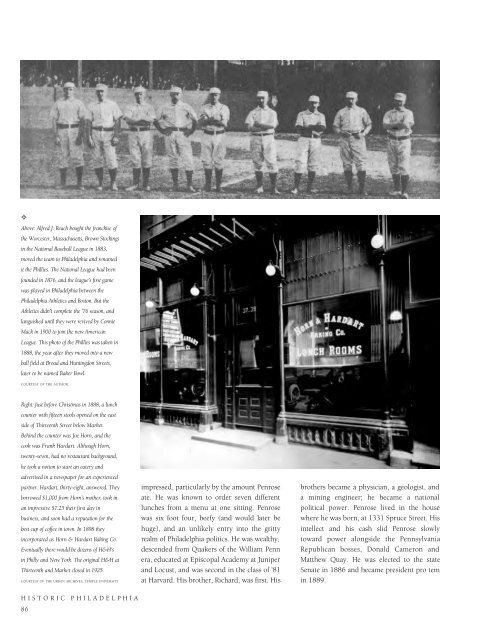Historic Philadelphia
An illustrated history of the city of Philadelphia, paired with the histories of companies, families and organizations that make the region great.
An illustrated history of the city of Philadelphia, paired with the histories of companies, families and organizations that make the region great.
Create successful ePaper yourself
Turn your PDF publications into a flip-book with our unique Google optimized e-Paper software.
✧<br />
Above: Alfred J. Reach bought the franchise of<br />
the Worcester, Massachusetts, Brown Stockings<br />
in the National Baseball League in 1883,<br />
moved the team to <strong>Philadelphia</strong> and renamed<br />
it the Phillies. The National League had been<br />
founded in 1876, and the league’s first game<br />
was played in <strong>Philadelphia</strong> between the<br />
<strong>Philadelphia</strong> Athletics and Boston. But the<br />
Athletics didn’t complete the ’76 season, and<br />
languished until they were revived by Connie<br />
Mack in 1900 to join the new American<br />
League. This photo of the Phillies was taken in<br />
1888, the year after they moved into a new<br />
ball field at Broad and Huntingdon Streets,<br />
later to be named Baker Bowl.<br />
COURTESY OF THE AUTHOR.<br />
Right: Just before Christmas in 1888, a lunch<br />
counter with fifteen stools opened on the east<br />
side of Thirteenth Street below Market.<br />
Behind the counter was Joe Horn, and the<br />
cook was Frank Hardart. Although Horn,<br />
twenty-seven, had no restaurant background,<br />
he took a notion to start an eatery and<br />
advertised in a newspaper for an experienced<br />
partner. Hardart, thirty-eight, answered. They<br />
borrowed $1,000 from Horn’s mother, took in<br />
an impressive $7.25 their first day in<br />
business, and soon had a reputation for the<br />
best cup of coffee in town. In 1898 they<br />
incorporated as Horn & Hardart Baking Co.<br />
Eventually there would be dozens of H&H’s<br />
in Philly and New York. The original H&H at<br />
Thirteenth and Market closed in 1925.<br />
COURTESY OF THE URBAN ARCHIVES, TEMPLE UNIVERSITY.<br />
HISTORIC PHILADELPHIA<br />
86<br />
impressed, particularly by the amount Penrose<br />
ate. He was known to order seven different<br />
lunches from a menu at one sitting. Penrose<br />
was six foot four, beefy (and would later be<br />
huge), and an unlikely entry into the gritty<br />
realm of <strong>Philadelphia</strong> politics. He was wealthy,<br />
descended from Quakers of the William Penn<br />
era, educated at Episcopal Academy at Juniper<br />
and Locust, and was second in the class of ’81<br />
at Harvard. His brother, Richard, was first. His<br />
brothers became a physician, a geologist, and<br />
a mining engineer; he became a national<br />
political power. Penrose lived in the house<br />
where he was born, at 1331 Spruce Street. His<br />
intellect and his cash slid Penrose slowly<br />
toward power alongside the Pennsylvania<br />
Republican bosses, Donald Cameron and<br />
Matthew Quay. He was elected to the state<br />
Senate in 1886 and became president pro tem<br />
in 1889.
















